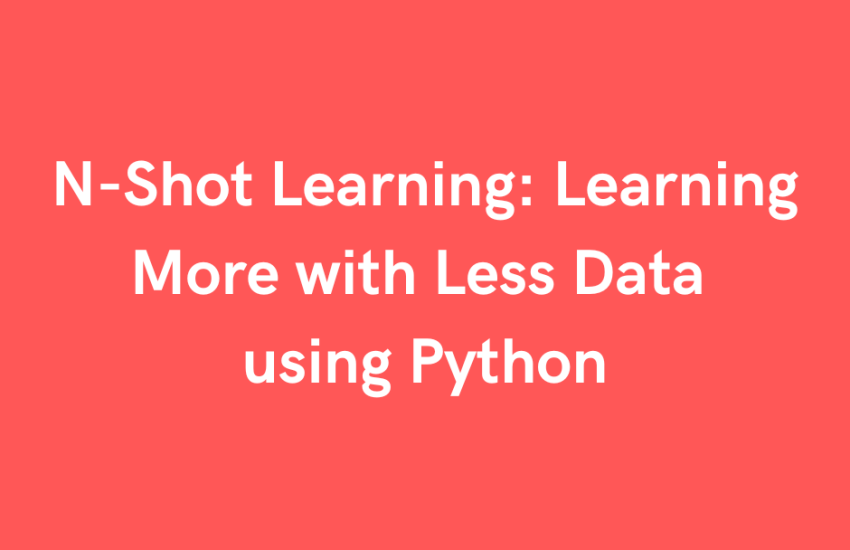Traditional machine learning models often require large amounts of labeled data to generalize well to new, unseen examples. However, in many real-world scenarios, collecting and annotating massive datasets can be impractical or costly. N-Shot Learning addresses this challenge by enabling models to learn from a limited number of examples, thus making the learning process more efficient and adaptable.
In N-Shot Learning, the ‘N’ refers to the number of examples available per class for training. This contrasts with traditional machine learning, where a more extensive dataset is required for effective training. These models aim to understand and generalize from a small number of instances, simulating a scenario where the model encounters new classes with minimal examples.
Key Concepts of N-Shot Learning
1. Support Set and Query Set:
- Support Set: This is the small set of labeled examples used for training the model. It typically consists of a few examples per class.
- Query Set: After the model is trained on the support set, it is evaluated on a query set containing examples from the same classes but not seen during training.
2. Meta-Learning:
N-shot learning often employs meta-learning techniques. Meta-learning entails the process of training a model to acquire the ability to quickly adapt and generalize to new tasks, effectively learning how to learn from a limited amount of data. In the context of N-Shot Learning, the model is trained on various tasks, each with its support and query sets, enabling it to generalize better to new tasks with minimal data.
3. Embedding Space:
N-Shot models often use an embedding space where similar examples are close to each other. This helps the model to generalize well even with limited data.
Python Implementation
Let’s create a simple Python implementation using a popular deep-learning library, TensorFlow, and its high-level API, Keras. We’ll build a basic N-Shot Learning model using a few examples from the Omniglot dataset, which is commonly used for few-shot learning tasks
import tensorflow as tf
from tensorflow import keras
from tensorflow.keras import layers
from tensorflow.keras.optimizers import Adam
from tensorflow.keras.losses import CategoricalCrossentropy
from tensorflow.keras.metrics import Accuracy
# Load Omniglot dataset
omniglot = tf.keras.datasets.omniglot
(train_images, _), (test_images, _) = omniglot.load_data()
# Normalize images to range [0, 1]
train_images = train_images.astype("float32") / 255.0
test_images = test_images.astype("float32") / 255.0
# Define the model architecture
def get_model(input_shape, num_classes):
model = keras.Sequential([
layers.Flatten(input_shape=input_shape),
layers.Dense(64, activation="relu"),
layers.Dense(num_classes, activation="softmax")
])
return model
# N-Shot Learning training function
def n_shot_learning_train(model, support_set, query_set, num_classes, epochs=5):
optimizer = Adam(learning_rate=0.001)
loss_fn = CategoricalCrossentropy()
accuracy_metric = Accuracy()
for epoch in range(epochs):
# Train the model to the support set
model.compile(optimizer=optimizer, loss=loss_fn, metrics=[accuracy_metric])
model.fit(support_set[0], support_set[1], epochs=1, verbose=0)
# Evaluate the query set
model.compile(optimizer=optimizer, loss=loss_fn, metrics=[accuracy_metric])
_, accuracy = model.evaluate(query_set[0], query_set[1], verbose=0)
print(f"Epoch {epoch + 1}/{epochs}, Accuracy: {accuracy * 100:.2f}%")
# Prepare a simple support set and query set (for demonstration purposes)
num_classes = 5
num_support_examples = 1
num_query_examples = 5
support_set = (
train_images[:num_classes, :num_support_examples],
keras.utils.to_categorical(range(num_classes)).repeat(num_support_examples, axis=0)
)
query_set = (
test_images[:num_classes, :num_query_examples],
keras.utils.to_categorical(range(num_classes)).repeat(num_query_examples, axis=0)
)
# Reshape the sets for the model
support_set = (support_set[0].reshape(-1, *support_set[0].shape[2:]), support_set[1])
query_set = (query_set[0].reshape(-1, *query_set[0].shape[2:]), query_set[1])
# Create and train the N-Shot Learning model
input_shape = support_set[0][0].shape
model = get_model(input_shape, num_classes)
n_shot_learning_train(model, support_set, query_set, num_classes)
This simple example demonstrates the basic structure of an N-Shot model using a few examples from the Omniglot dataset. In a real-world scenario, more sophisticated architectures, meta-learning techniques, and larger datasets would be employed for improved performance. Additionally, adapting this code for various N-Shot Learning benchmarks and datasets is recommended for comprehensive evaluation.
Note:
N-Shot Learning provides a promising approach for scenarios where data is limited, and traditional machine learning models struggle to generalize effectively. By leveraging a small support set during training, models can learn to adapt quickly to new classes with minimal examples. The provided Python implementation serves as a starting point for understanding the basic concepts and can be expanded upon for more complex tasks and datasets.




